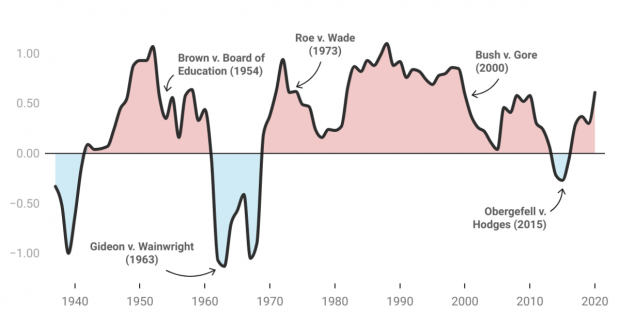How Supreme Court Ideology Has Shifted Over Time

Judge Ketanji Brown Jackson made history in June when she was sworn in as the first black female Supreme Court justice, replacing the retiring Justice Stephen Breyer. How does her confirmation affect the judicial ideology of the Supreme Court?
Conservative Justices outnumbered liberal justices by 6-3 at the conclusion of the October 2020 Supreme Court term, based on their Martin-Quinn scores, which is an analysis of a dataset of the Justice’s voting record during a term, based on how often they agree or vote with each other. The score following the term placed Breyer as its second-most liberal member.
Like any similar statistical model, it should be noted that Martin-Quinn scores has some limitations in how it measures bias. For one, it looks solely at the vote from each Justice in each case during a given year – some may argue that judicial ideology should factor in oral arguments and the fact that the Court has discretion over the cases that it will hear. Furthermore, not all outcomes of Supreme Court cases can be easily described as “liberal” or “conservative” – bias is subjective, and there is no concrete definition of what “center” or “moderate” is.
(Side note: Here at AllSides, our media bias ratings system is designed to reflect the average judgment of all Americans across the political spectrum if they had the opportunity to read and evaluate the content. That means that a “Center” rating from AllSides is intended to reflect how all Americans on average would rate that content.)
Since the 1940’s, the Supreme Court has most often been conservative in ideology, according to the Martin-Quinn scores. A couple of exceptions include a swing in liberal ideology during and after the Civil Rights Era, and slight lean-liberal ideology during President Obama’s second term in office. Since President Donald Trump’s tenure in office, the Court has trended further conservative, on average, in part due to the former President’s three confirmations.
The below graph is based on the median Justice during each respective term. Negative values indicate liberal ideology, and positive values indicate conservative ideology.
The individual ideology of Justices also tends to shift with time. In the graph above, red lines represent Justices nominated by a Republican president and blue lines represent Justices nominated by a Democratic president. Dotted lines indicate Justices who no longer serve on the Court.
In Justice Breyer’s 28 years on the Court, he became more liberal over time, along with Justice Sotomayor and Chief Justice Roberts. Justice Alito has become more conservative with time, and Justice Thomas has remained relatively stagnant over the last decade.
Public Perception of the Ideology of the U.S. Supreme Court: Too Liberal or Conservative?
Public perception of Supreme Court ideology has also shifted over time, according to Gallup (Center bias). Unsurprising to some, more Americans perceived the Court as “too liberal” during President Obama’s tenure in office and as “too conservative” while President Trump was in office. Today, about 4 in 10 Americans perceive the Court’s judicial ideology as “about right” — in other words, relatively nonpartisan or balanced.
According to a September 2021 YouGov/The Economist (Lean Left bias) poll, just one in four (24%) U.S. adults believe that the Supreme Court is fair and impartial – more Americans believe the Court is biased against Democrats (29%) than biased against Republicans (19%).
A Pew Research Center (Center bias) survey in January 2022 found that 48% of U.S. adults view the Supreme Court as “middle of the road” ideologically, while 38% view it as “conservative” and about 1 in 10 (9%) view the Court as “liberal.”
To that end, it remains to be seen how public opinion will shift due to Jackson joining the Supreme Court. The Supreme Court will also be ruling on Dobbs v. Jackson Women's Health Organization this term – a decision that may result in overturning the precedence of Roe v. Wade – which may further shift public opinion of the ideology of the Supreme Court.
Read more about the U.S. Supreme Court on AllSides.
Editor's Note: This article was updated July 5, 2022 to reflect Jackson's official replacement of Breyer.
Andrew Weinzierl is the Research Assistant & Data Journalist at AllSides. He has a Lean Left bias.
This piece was reviewed by Antonio Ferme, AllSides Weekend Editor (Center bias), Managing Editor Henry A. Brechter (Center bias), News Research Intern Ethan Horowitz (Lean Right bias), and CEO John Gable (Lean Right bias).

May 13th, 2024

May 9th, 2024

May 7th, 2024

May 7th, 2024